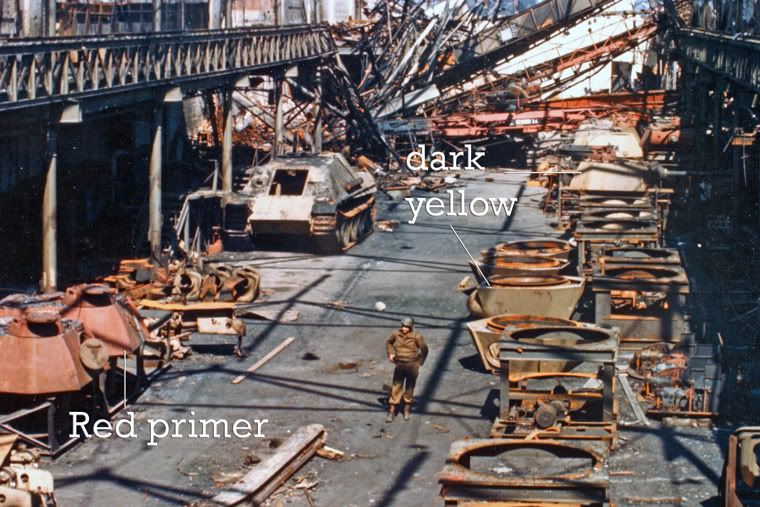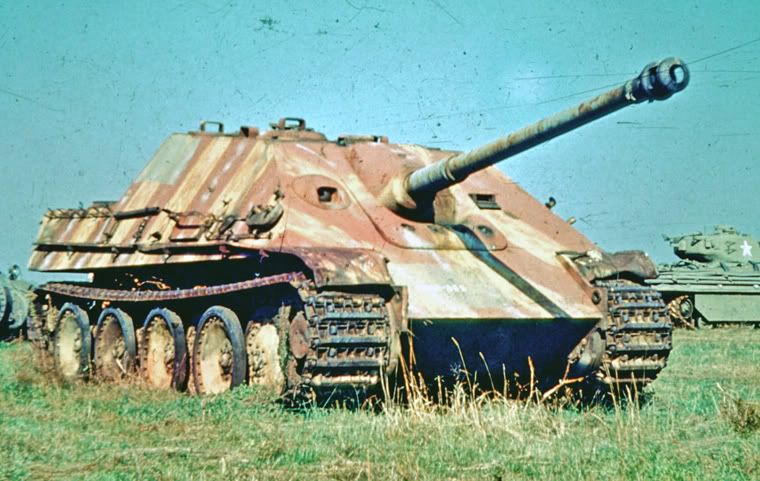Quais seriam as cores das duas versÕes do link abaixo?
Replies sorted oldest to newest
Late-war, 1943-1945
On 18 February 1943, all vehicles were ordered to be painted in a base coat of Dunkelgelb RAL 7028 (dark yellow). Only small pieces of equipment were to retain their previous color. On top of the Dunkelgelb base coat, stripes ofRotbraun RAL 8017 (red-brown) and Olivgrün RAL 6003 (olive green) was applied.
The Rotbraun and Olivgrün paint was delivered to the units in tins, which were thinned with any available liquid. It was then applied by the maintenance section, which allowed the pattern to match the terrain. This also resulted in a wide variety of patterns, from elaborate sprayed camouflage, to patterns that look like they were smeared on with a broom and rag.
To standardize and improve camouflage patterns, on 19 August 1944, it was ordered that all vehicles were to be painted at the factory. The pattern, Hinterhalt-Tarnung (ambush camouflage), still used a base color of Dunkelgelb, with Rotbraun and Olivgrün stripes. On top of each color, small dots of the other two were applied. This pattern was created to give the appearance of the sun shining through forest foliage.
In mid-September 1944, vehicles started leaving the factories in their red oxide primer, with only sparse camouflage. On 31 October 1944, more elaborate camouflage in Dunkelgelb, Rotbraun and Olivgrün began being applied at the factories over the red oxide primer. Furthermore, Dunkelgrau could be used if Dunkelgelb was unavailable. Despite this order, there has never been any evidence that Dunkelgrau was actually used.
On 20 December 1944, it was ordered that a Dunkelgrün base coat, with a hard-edge pattern of Dunkelgelb and Rotbraun should be used.
O Panther do link é um A e não um D! Utiliza zimmerit obrigatoriamente e pode ser pintando só DY, embora os números vermelhos indiquem Normandia, daí a variação de camuflagem é grande , vai depender da divisão!
Assef,
Os números vermelhos tbm foram usados em outras frentes:
Ucrânia,1st SS. Tcheco eslováquia, 27Th Pz Reg., Russia 16th Pz. Div. embora estes fossem ausf D.
O ausf. A ( Que são posteriores ao D ) usaram numeração vermelha na Itália.4th Pz.Reg. e Polonia 23rd. Pz. Reg. 12th SS Pz.Div., 12th SS Pz. Reg. e 24th Pz. Reg Normandia
Usaram numeração vermelha nas Ardenas os ausf. G do 130th. Lehr Div. e o 27th pz.reg. em Varsóvia.
Qnto ao Zimeritt nos Ausf.A, realmente é quase obrigatório.
As poucas referencias que encontrei s/ o zimeritt foram :
Panther A II011 ( Branco ) comandado pelo SS-untersturmführer Renz da 5th SS Pz. Regiment na Ucrânia primavera de 44,
Pz. V A 304 ( vermelho ) do comandante da 3rd Co. 12th SS Pz Reg. Normandia junho de 44,
Pz. V A 701 ( preto )do Hptm. Fischer 23rd Pz. Div. Cherkassy janeiro de 44
Pv. V A 432 ( Branco ) do Lt. Weidemann 24th Pz. Reg. Normandia 44
Uma imagem do photobucket do S. Szaloga que pode contribuir.

[]s
JEP Annoni
Agora cabe uma pergunta:
Neste jagdpanther.

Ele foi camuflado com marrom ou só com o dark Yellow sobre o primer de zarcão?
[]s
JEP
Jep, está foto é de um carro de museu?
A foto é antiga do Jagdpanther que está em Aberdeen. Ele está muito enferrujado e a cor desbotada, e já foi repintado. No original era todo em Red Oxide com faixas retas em DY nas laterais e frontal.
Se pesquisar nos veiculos em Abrdeen é possivel encontrar alguma foto dele mais "novo".
http://www.network54.com/Forum...rdeen+Jagdpanther+...
http://www.network54.com/Forum...nks+of+WWII+in+COLOR
Valls





